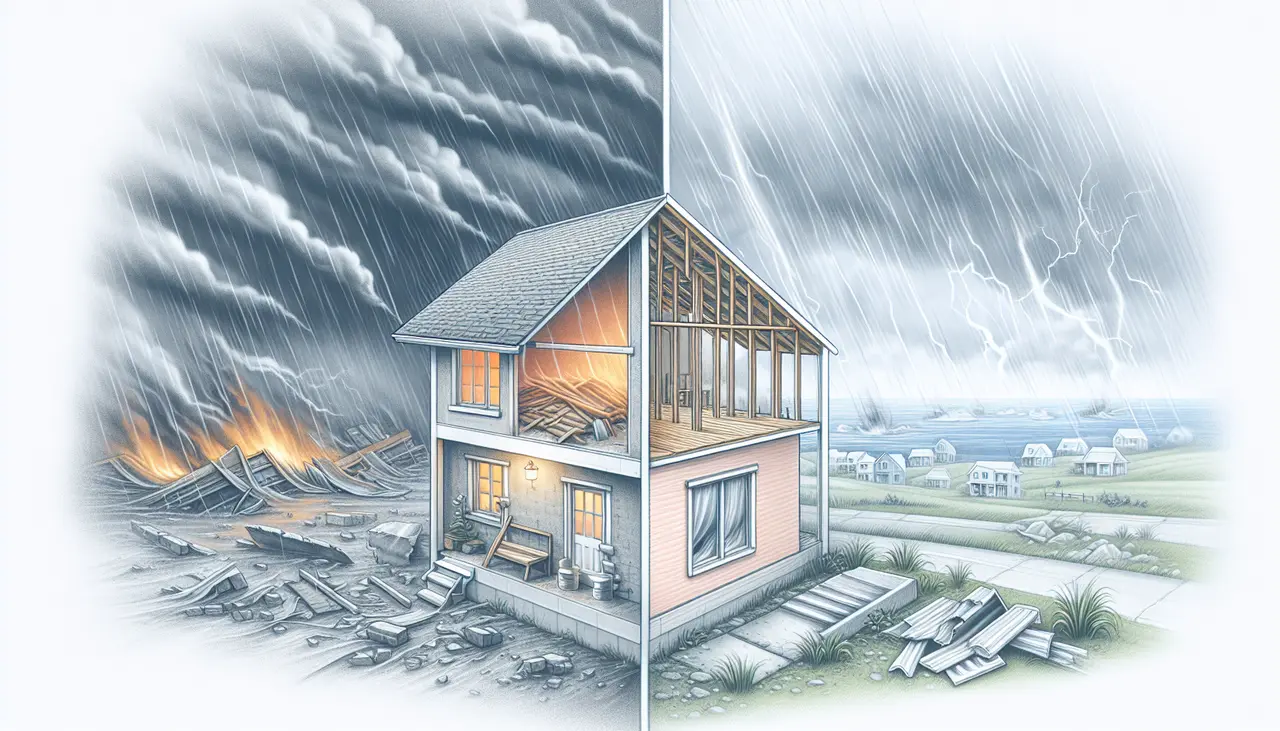Understanding TPO Roofing: What Is It?
TPO stands for thermoplastic polyolefin, which is a fancy way to say it’s a single-ply roofing membrane that works great for covering flat roofs. This roofing material has grown popular because it’s tough against the elements, it reflects sunlight to keep buildings cooler, and it’s not too hard on your wallet. When you choose TPO, you’re betting on a reliable cover that helps protect your building from rain, wind, and even those harsh UV rays. Plus, it’s lighter than traditional roofing materials, which means it won’t weigh down your building. In short, TPO roofing is a smart move for weatherproofing your property without breaking the bank.

The Impact of Storm Damage on Your Property
When a storm hits, it’s not just rain and wind; it’s a test of your property’s resilience. Damage can range from missing shingles to severe structural harm. Water can sneak through cracks, leading to mold and rot, while high winds rip away materials, leaving your roof vulnerable. Even minor damage can escalate, causing costly repairs over time. Immediate assessment and repair after a storm are vital for protecting your property and wallet.
How TPO Roofing Offers Protection Against Harsh Weather
TPO roofing stands tough against extreme weather. It’s made of a single-ply roofing membrane that’s both flexible and durable, a warrior’s armor for roofs. Picture it holding the fort against high winds, repelling hail, and withstanding heavy rain. TPO’s heat-reflective surface also means the sun’s rays bounce back, keeping buildings cooler and fighting off the UV attacks that can make other roofs wear down faster. Plus, this material is resistant to mold, dirt, and tears—essentially, it doesn’t give in easily. With TPO roofing, your property is guarded against the elements, potentially saving you costly repairs in the future. It’s a shield in the battle against storm damage.
The Durability and Strength of TPO Roofing Materials
TPO roofing, short for thermoplastic olefin, stands strong against the rage of storms. It’s designed to last, boasting a life of up to 20 to 30 years with proper installation and maintenance. Its resilience is proven as it resists tears, punctures, and even impacts that would dent or damage less sturdy materials. Plus, TPO’s heat-welded seams form an impenetrable barrier, superior to those of traditional roofing. This kind of muscle means that when a storm hits, your building has a much better chance of staying snug and dry. The material isn’t just tough; it also stands up to UV rays without breaking a sweat, helping to keep your cooling costs down. So, when you’re weighing your options, remember that TPO roofing is like a shield—solid, dependable, and ready for whatever the sky throws its way.
Installation of TPO Roofing: Ensuring Maximum Storm Resistance
When upgrading to TPO roofing, proper installation is key to maximizing storm resistance. This durable material can withstand harsh weather, but it’s crucial that a licensed professional does the job. They’ll make sure that the membrane is securely fastened and that all seams are heat-welded to prevent leaks. Remember, a well-installed TPO roof not only defends against rain, wind, and hail but can also save you from costly water damage repairs down the line. Invest in professional installation to ensure your property is sheltered when storms hit.
Comparing TPO Roofing with Other Types of Roofing Solutions
When you’re sizing up TPO roofing against other contenders, it’s like setting up a heavyweight match. TPO comes into the ring boasting durability, energy efficiency, and a wallet-friendly price tag. Traditional options like asphalt shingles are the old-school fighters – they’re cheaper upfront but often throw in the towel sooner under harsh weather. Metal roofing, on the other hand, is like the seasoned pro – tough as nails and lasting an age but comes with a steeper cost to install.
Now, rubber EPDM roofs are the flexible fighters; they’ve got a decent lifespan and resilience going for them. Yet when you put them head-to-head with TPO, TPO’s heat-welded seams make it the champion in preventing leaks and wind uplift. That seam strength can be a real knockout in storm-heavy rounds.
So, here’s the deal with TPO: you won’t bleed out cash for cooling since it’s got a reflective surface kicking UV rays to the curb and it often comes with a warranty swinging from 15 to 20 years. Other types might have a lower sticker price, but TPO’s blend of cost-effectiveness and performance could save you a heap of trouble when the storm clouds roll in.
Maintenance Tips for TPO Roofing Post-Storm
After a storm, your TPO (Thermoplastic Polyolefin) roofing deserves attention to ensure it continues to protect your property effectively. Start by clearing debris gently off the surface. Branches, leaves, and other foreign objects can cause surface wear if ignored. Inspect the roofing for any punctures, tears, or ripples; storm-battered roofing can often show such stress signs. When checking the seams, ensure they are intact because they are critical to preventing leaks. If you spot any issues, getting them fixed promptly is crucial to prevent further damage. Keep an eye on the drainage system too, as clogged drains can cause water to pool and lead to roofing problems over time. Regular maintenance, like cleaning and spot checks, will save you from hefty repair bills and prolong the life of your TPO roofing. After all, it’s easier to tackle small repairs than to deal with a full-blown roofing disaster.
The Cost-Benefit Analysis of Investing in TPO Roofing
TPO roofing, short for Thermoplastic Polyolefin, is a smart investment when you’re staring down the barrel of potential storm damage. It’s like a shield for your business or home, strong against wind, rain, and hail. Upfront, you might find TPO is pricier than some other materials — think of it in the $3.50 to $7.50 per square foot ballpark. But don’t let the initial cost spook you. TPO is a champion in the long haul. It’s durable, energy-efficient, and can last up to 20 years or more with the proper care. That’s a lot of storms it’s pushing back against. Your energy bills can see a drop, too, because TPO reflects sunlight like a boss, keeping things cool. So, while you’re dishing out cash at the start, the savings on repairs and energy can make it worth your while. More than just saving money, it’s about peace of mind. When the storm clouds roll in, you’ll thank yourself for choosing TPO’s strong defensive game.
Real-Life Examples: TPO Roofing Surviving Severe Storms
Stories of TPO roofing withstanding Mother Nature’s fury pepper conversations among contractors. Take, for example, a warehouse in Oklahoma that shrugged off a fierce tornado, its TPO membrane emerging without a scratch while neighboring buildings suffered extensive harm. Then there’s the hospital in Florida that weathered a major hurricane, the TPO roof holding fast against relentless winds that tore away at other structures. These accounts aren’t tall tales—they’re testimonials to the resilience of TPO roofing in the face of violent storms. Property owners who’ve seen their TPO roofs come through unscathed can’t help but praise the material’s toughness, reinforcing the reputation of TPO as a shield against the havoc of high winds and lashing rains.
Final Thoughts: Is TPO Roofing Right for Your Property?
When it’s time to decide, you’ve got to weigh all sides. TPO roofing is tough, no-nonsense protection for your building. It reflects UV rays, which means less air-con running and more money in your pocket. It’s good at fighting off chemical exposure, ozone, and algae, so if your area’s got harsh conditions, TPO’s got your back. It’s also a champ at dealing with storm damage. That’s not all, installation is faster than a hiccup, without making your wallet too much lighter. But remember, it’s not for everybody. If your roof’s got more angles than a geometry book, or if you like changing styles as often as the weather changes, maybe look elsewhere. So, gear up and make the choice that’s best for your property. If you want a roofing workhorse that’s cost-effective, energy-efficient, and durable, TPO could be your knight in shining armor.





